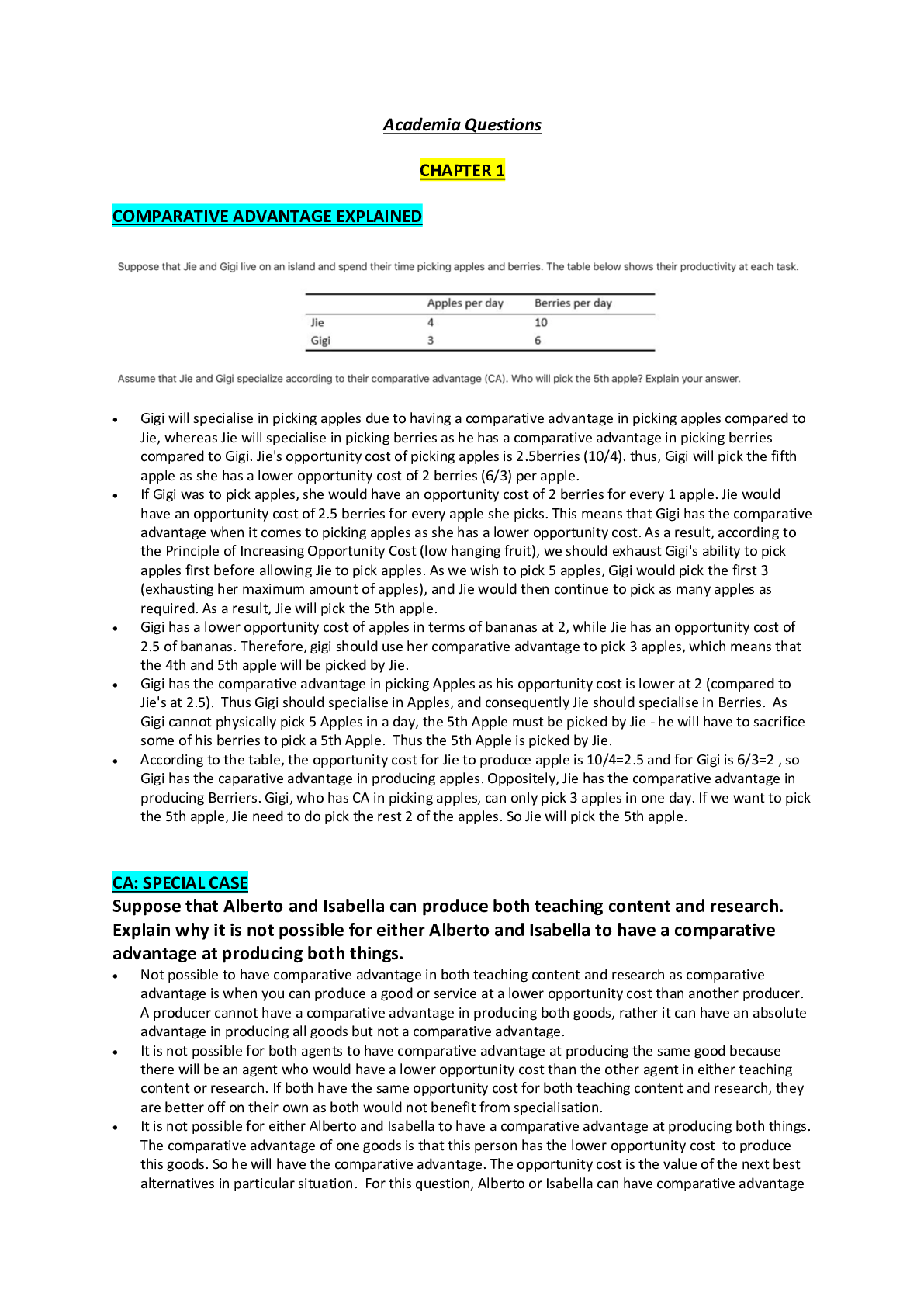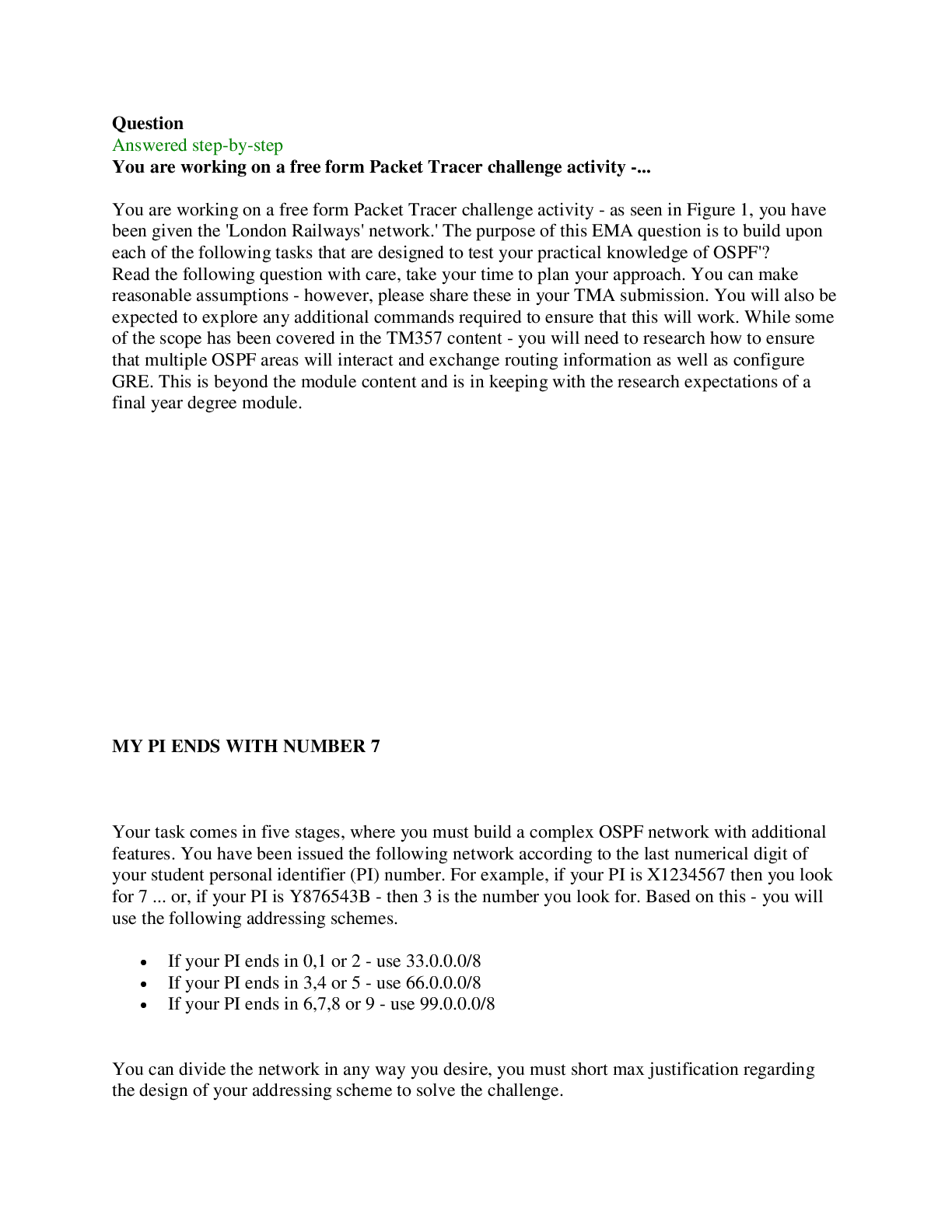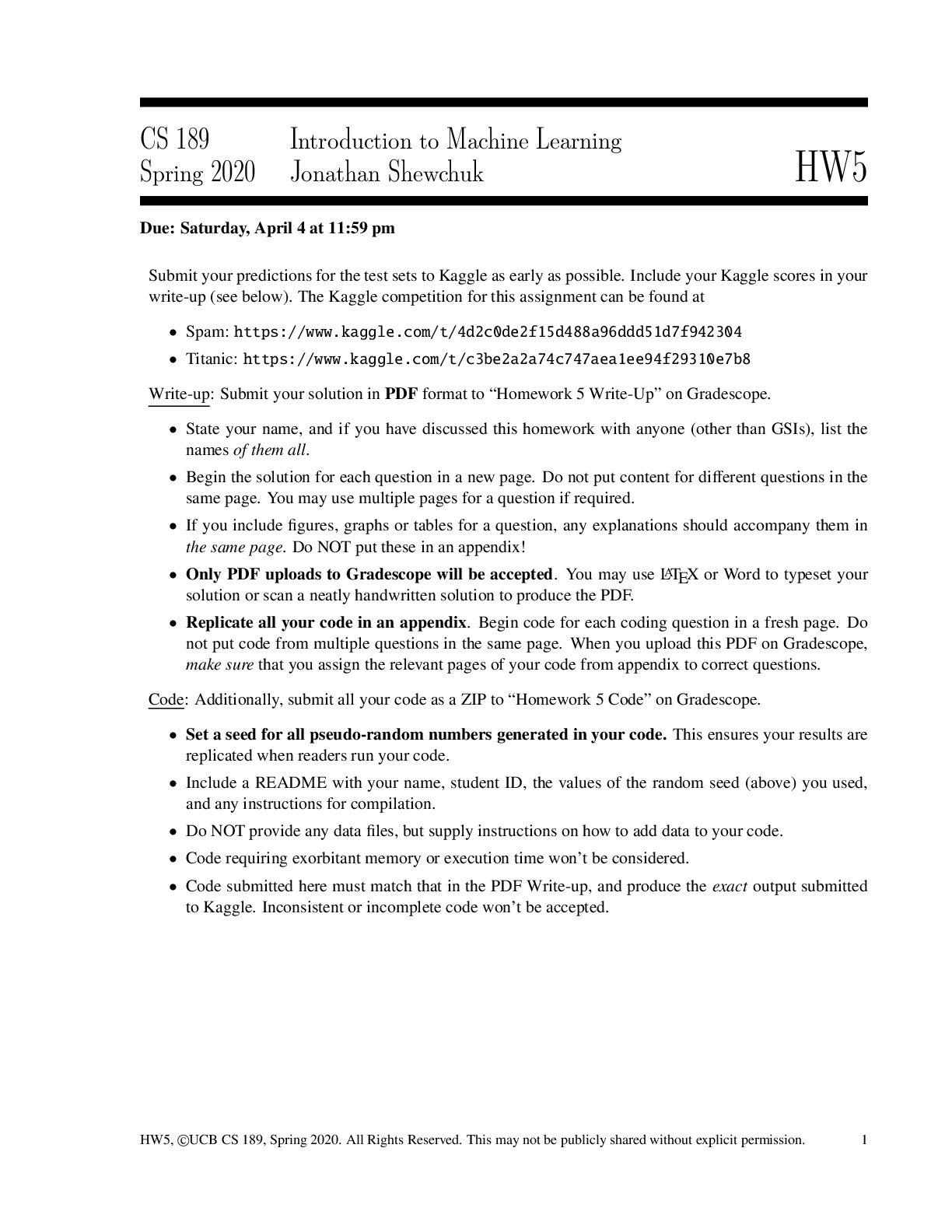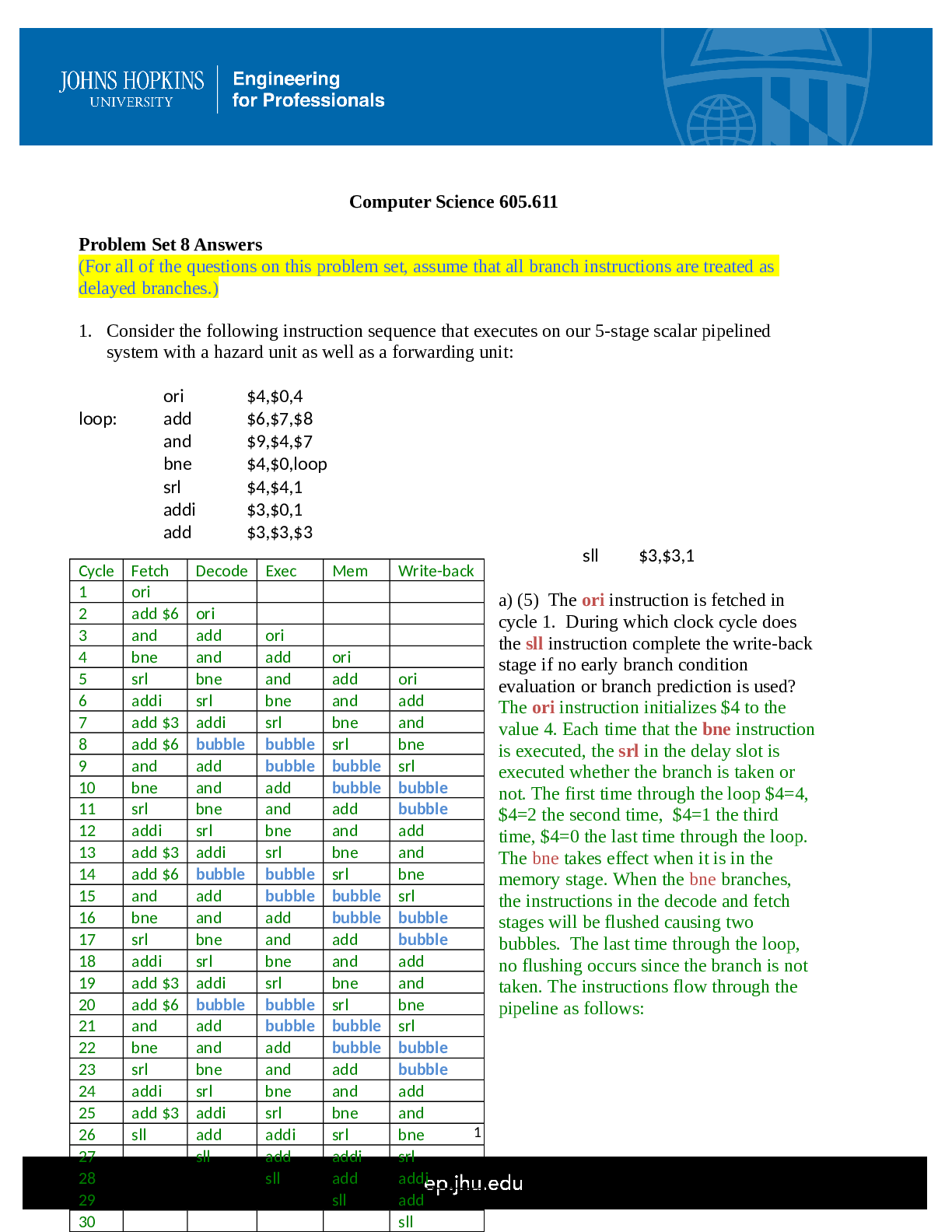Business > QUESTIONS & ANSWERS > Academia Questions CHAPTER 1 COMPARATIVE ADVANTAGE EXPLAINED (All)
Academia Questions CHAPTER 1 COMPARATIVE ADVANTAGE EXPLAINED
Document Content and Description Below
COMPARATIVE ADVANTAGE EXPLAINED • Gigi will specialise in picking apples due to having a comparative advantage in picking apples compared to Jie, whereas Jie will specialise in picking berries as ... he has a comparative advantage in picking berries compared to Gigi. Jie's opportunity cost of picking apples is 2.5berries (10/4). thus, Gigi will pick the fifth apple as she has a lower opportunity cost of 2 berries (6/3) per apple. • If Gigi was to pick apples, she would have an opportunity cost of 2 berries for every 1 apple. Jie would have an opportunity cost of 2.5 berries for every apple she picks. This means that Gigi has the comparative advantage when it comes to picking apples as she has a lower opportunity cost. As a result, according to the Principle of Increasing Opportunity Cost (low hanging fruit), we should exhaust Gigi's ability to pick apples first before allowing Jie to pick apples. As we wish to pick 5 apples, Gigi would pick the first 3 (exhausting her maximum amount of apples), and Jie would then continue to pick as many apples as required. As a result, Jie will pick the 5th apple. • Gigi has a lower opportunity cost of apples in terms of bananas at 2, while Jie has an opportunity cost of 2.5 of bananas. Therefore, gigi should use her comparative advantage to pick 3 apples, which means that the 4th and 5th apple will be picked by Jie. • Gigi has the comparative advantage in picking Apples as his opportunity cost is lower at 2 (compared to Jie's at 2.5). Thus Gigi should specialise in Apples, and consequently Jie should specialise in Berries. As Gigi cannot physically pick 5 Apples in a day, the 5th Apple must be picked by Jie - he will have to sacrifice some of his berries to pick a 5th Apple. Thus the 5th Apple is picked by Jie. • According to the table, the opportunity cost for Jie to produce apple is 10/4=2.5 and for Gigi is 6/3=2 , so Gigi has the caparative advantage in producing apples. Oppositely, Jie has the comparative advantage in producing Berriers. Gigi, who has CA in picking apples, can only pick 3 apples in one day. If we want to pick the 5th apple, Jie need to do pick the rest 2 of the apples. So Jie will pick the 5th apple. CA: SPECIAL CASE Suppose that Alberto and Isabella can produce both teaching content and research. Explain why it is not possible for either Alberto and Isabella to have a comparative advantage at producing both things. • Not possible to have comparative advantage in both teaching content and research as comparative advantage is when you can produce a good or service at a lower opportunity cost than another producer. A producer cannot have a comparative advantage in producing both goods, rather it can have an absolute advantage in producing all goods but not a comparative advantage. • It is not possible for both agents to have comparative advantage at producing the same good because there will be an agent who would have a lower opportunity cost than the other agent in either teaching content or research. If both have the same opportunity cost for both teaching content and research, they are better off on their own as both would not benefit from specialisation. • It is not possible for either Alberto and Isabella to have a comparative advantage at producing both things. The comparative advantage of one goods is that this person has the lower opportunity cost to produce this goods. So he will have the comparative advantage. The opportunity cost is the value of the next best alternatives in particular situation. For this question, Alberto or Isabella can have comparative advantagein teaching content and research. However, if Alberto has comparative advantage in teaching content and research, this means the opportunity cost of doing these two action is lower than Isabella do. So Isabella will have no comparative advantage in teaching content and research as she has higher opportunity cost. So there will be only one person who can have comparative advantage in teaching content and research. • Comparative advantage and opportunity cost points to the relationship between the production of two goods where their relationship is inverse. Teaching content and research cannot be quantified but is rather based off the quality. So time in this sense has no affect on the quantity but the quality. OC: AN EXAMPLE Isabella is a student and also works part-time as a waitress earning $10 per hour. Isabella was invited to attend a play on Sunday afternoon. Attending the play will take 2 hours, and a ticket costs $60. If Isabella were to spend the time studying for an exam, she will receive an HD instead of a D. She values a HD over a D at $40. What is Isabella’s opportunity cost (OC) of attending the play? Explain your answer. • The opportunity cost of attending the play is the next best alternative, that is, studying for an exam and receiving a HD. The OC is therefore the value of the HD ($40) + the value of the ticket to the play ($60) that she saves in staying home = $100. • During the 2 hours in which Isabella attends the play, she could spend that time to either work or study. Working will give her a benefit of $10 x 2 = $20 whilst studying will give Isabella a HD instead of D (for which she values the HD at $40). Opportunity cost is determined by the next best alternative, and in this case, it is studying ($40 (study)>$20 (job)). This means that her opportunity cost for attending the play is $40. • The next best alternative for Isabella is to study which she values at $40. Her opportunity cost of going to the play would be the valued $40 + $60 (the cost of the play ticket) = $100 • According to the definition, opportunity cost is the value of the next best alternative to that action. In this case, apart from the value of Isabella's attending the play, which costs $60 and 2 hours, she could earn $20 by doing her part-time job, or study for a HD which worths $40 to her. Therefore, studying is the next best alternative that could've brought her $40. In addition to the cost of the ticket (as she would not need to pay for it if she chooses to study instead), the opportunity cost of attending the play would be $100. • The opportunity cost is the amount sacrificed of the next best option as such the opportunity cost for Isabella is 60 + 40 = $100. By contrasting the value of studying versus working, it becomes clear that studying is Isabella’s next best option (40>(10x2)). If she decides to study instead of attending the play, she also saves $60. As such the opportunity cost is $100. • Isabella's opportunity cost of attending the play would be $120 dollars. This is due to her being able to earn 20 dollars from work (2 hours, 10 dollars and hour), her receiving a HD in her exam which she values at 40 dollars and the tickets to the play($60). Hence, adding all these up, it will total to $120. • During the 2 hours in which Isabella attends the play, she could spend that time to either work or study. Working will give her a benefit of $10 x 2 = $20 whilst studying will give Isabella a HD instead of D (for which she values the HD at $40). Opportunity cost is determined by the next best alternative, and in this case, it is studying ($40 (study)>$20 (job)). This means that her opportunity cost for attending the play is $40. • The next best alternative for Isabella is to study which she values at $40. Her opportunity cost of going to the play would be the valued $40 + $60 (the cost of the play ticket) = $100 • Opportunity cost is defined as the value of the next best alternative, in comparison to the chosen action. If Isabella doesn’t attend the play, she could be a) working, or b) studying for her exam to achieve a HD. If she chooses to work, she will gain $20 in salary, plus the $60 she will save from the play ticket, totalling to $80. If she chooses to study, she will gain the $40 she values from a HD, and the $60 from the play ticket, totalling to $100. Thus, her opportunity cost of watching the play is the value of the next best alternativestudying, and is valued at $100. OCDefine the concept of Opportunity Cost and state the Low Hanging Fruit Principle (or Principle of Increasing Opportunity Cost). Explain these two concepts using a real-wold example. • Opportunity cost refers to the value of the next best alternative to that particular action. The LHFP refers to how an economy must first employ those agents/producers with the lowest opportunity cost, and only once those have been exhausted, turn to the second lowest OC and once that is exhausted, repeating the process. A real world example would be collecting coconuts. There are people who inherently will have a lower opportunity cost for collecting coconuts as they are either taller, stronger or faster and hence the time spent collecting a coconut is less than others. By using the LHFP, the most efficient coconut collectors will be sent out first, and if the amount collected is not sufficient, the second most efficient will be sent out and so on until the amount collected is sufficient. • Opportunity Cost (OC) is the what is forgone when the next alternative is chosen. For example, if Nathan decided to make computers, he is forgoing the chance to produce phones. The Principle of the Low Hanging Fruit is concept where the producer with the lowest OC will be chosen to produce first until resources are depleted and then the next lowest OC will be chosen. In this scenario, say Nathan had a lower opportunity cost than Daniel to make computers, then Nathan would make all the computers he possibly could and then Daniel would start to produce computers. • Opportunity cost (OC) refers to the value of the next best alternative action which has been forgone. The Principle of Low Hanging-Fruit uses this concept to suggest when production of a good is to be increased, the resources with the lowest OC should be employed first. In order to illustrate this, let's consider an example where it's harvest season on Australian farms, and a particular farmer has 4 harvesting machines (A,B,C,D) to harvest either wheat or barley. Assume the farmer currently has machine A harvesting wheat, and the other 3 harvesting barley. However, the farmer realises that it is more profitable to harvest and sell the wheat first, and will need to reallocate 2 machines from barley harvesting to wheat harvesting. For this example, assume machine B in a week can harvest 2 tons of wheat, or 4 tons of barley. Machine C can harvest either 1 ton of wheat or 3 tons of barley in a week, and Machine D can harvest either 3 tons of wheat or 3 tons of barley. Since the farmer is choosing 2 of these machines to change to harvesting wheat, we calculate the OC of harvesting wheat instead of barley (how much barley could have been harvested instead of wheat). For Machine B, it costs 2 tons of barley for each ton of wheat, likewise for Machine C it will cost 3 tons of barley per ton of wheat, and Machine D will cost 1 ton of barley per 1 ton of wheat. In accordance with the Principle of Low Hanging Fruit, the farmer would first prefer to move machine D to wheat harvesting since it has the lowest OC to do so. The next machine the farmer chooses is machine B, which has the next lowest opportunity cost. Machine C will stay harvesting barley, since the farmer only needed to reallocate 2 machines, and C had the highest OC. • Opportunity cost is the value of the next best alternative to that action. The low hanging fruit principle states that in the process of producing the production of any good, one must first employ the resources with the least opportunity cost and once they are exhausted, they turn to the resource with the next lowest opportunity cost. For example, if Agent A can produce 10kg of apples in a day and 1kg of fish in a day while Agent B can produce 3kg of apples in a day or 3kg of fish in a day, Agent A has a lower opportunity cost in producing apples while Agent B has a lower opportunity cost in producing fish. And hence, according to the hanging fruit principle, Agent B must start to produce more fish first until he has run out of resources (time), before Agent A starts to produce fish. • Opportunity costs refer to the loss of benefit/potential gain of other productive activities when one specific alternative has been chosen. An example, if you spend time and money to watch a movie, you cannot spend that time reading a book. The opportunity cost of watching the movie is the money spent and the pleasure you forgo by choosing not to read the book. The Low Hanging Fruit Principle refers to an approach business executives take to focus on more easily achievable/attainable goals, which typically leads to faster results. For example in the name itself, as a fruit picker in an orchard, it is much easier and requires less effort to gather fruit that is low-hanging or within reach. If you wish to pick fruits that are growing higher up in the tree, you would need to get a ladder and move from tree to tree as you proceed picking fruits, requiring more effort. PPC: ADVANCED [Show More]
Last updated: 2 years ago
Preview 1 out of 104 pages

Buy this document to get the full access instantly
Instant Download Access after purchase
Buy NowInstant download
We Accept:

Reviews( 0 )
$7.00
Can't find what you want? Try our AI powered Search
Document information
Connected school, study & course
About the document
Uploaded On
Jul 21, 2022
Number of pages
104
Written in
Additional information
This document has been written for:
Uploaded
Jul 21, 2022
Downloads
0
Views
52














